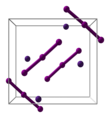Caesium triiodide
Appearance
(Redirected from Cesium triiodide)
| |||

| |||
| Identifiers | |||
|---|---|---|---|
3D model (JSmol)
|
|||
| ChemSpider | |||
| EC Number |
| ||
PubChem CID
|
|||
CompTox Dashboard (EPA)
|
|||
| |||
| |||
| Properties | |||
| CsI3 | |||
| Molar mass | 513.61886 g·mol−1 | ||
| Appearance | purple[1] | ||
| Melting point | 77 °C (decomposes)[2] | ||
Except where otherwise noted, data are given for materials in their standard state (at 25 °C [77 °F], 100 kPa).
| |||
Caesium triiodide is an inorganic compound, with the chemical formula of CsI3. It can be prepared by slow volatilization and crystallization of caesium iodide and iodine in aqueous ethanol solution.[3] It can form precipitates with diazobenzene.[4]
It undergoes a phase transition from Pnma to P-3c1 under high pressure, and its structure changes from layered to 3D.[5]
References
[edit]- ^ Ronald Rich (22 December 2007). Inorganic Reactions in Water. Springer. p. 472. ISBN 978-3-540-73962-3. Archived from the original on 2022-09-12. Retrieved 2022-09-12.
- ^ G.S. Harris, J.S. McKechnie (Jan 1982). "Thermogravimetric analysis and dissociation pressure of caesium tribalides". Polyhedron. 1 (2): 215–216. doi:10.1016/S0277-5387(00)80991-2. Archived from the original on 2018-06-09. Retrieved 2022-09-09.
- ^ Richard M. Bozorth, Linus Pauling (Jun 1925). "The Crystal Structures of Cesium Tri-Iodide and Cesium Dibromo-Iodide". Journal of the American Chemical Society. 47 (6): 1561–1571. doi:10.1021/ja01683a009. ISSN 0002-7863. Archived from the original on 2022-09-09. Retrieved 2022-09-09.
- ^ H. F. Halliwell, S. C. Nyburg (1960). "891. The reaction of the benzenediazonium ion with certain anions in aqueous acid solution". Journal of the Chemical Society (Resumed): 4603–4608. doi:10.1039/jr9600004603. ISSN 0368-1769. Retrieved 2022-09-09.
- ^ Tomasz Porȩba, Stefano Racioppi, Gaston Garbarino, Wolfgang Morgenroth, Mohamed Mezouar (2022-07-18). "Investigating the Structural Symmetrization of CsI 3 at High Pressures through Combined X-ray Diffraction Experiments and Theoretical Analysis". Inorganic Chemistry. 61 (28): 10977–10985. doi:10.1021/acs.inorgchem.2c01690. ISSN 0020-1669. PMID 35792580. S2CID 250313558. Archived from the original on 2022-09-09. Retrieved 2022-09-09.
{{cite journal}}: CS1 maint: multiple names: authors list (link)


